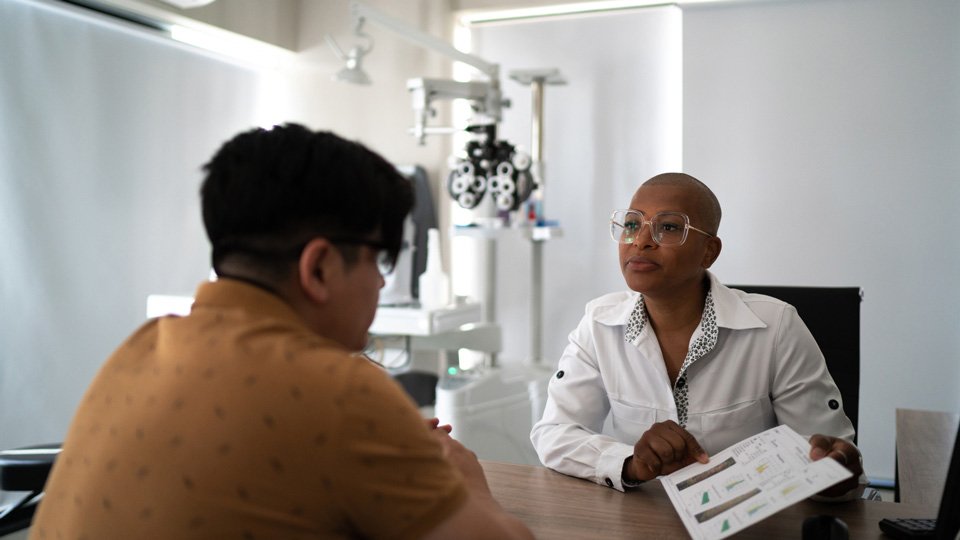Communicating with patients is a skill that many optometrists perform automatically.
During the eye examination, the way a practitioner interacts with patients – from their body language to the way they listen and ask questions – is a routine that can become second-nature through experience and repetition.
As with any longstanding skill, an optometrist can benefit from stepping back and assessing whether the way they communicate with patients can be refined or improved.
To explore best practice in this area, OT interviewed a group of researchers and optometrists who have collaborated to develop a communication skills portfolio which is available on the College of Optometrists website.
The evidence-based tips were compiled after researchers analysed video recordings of 124 eye examinations to determine how verbal and non-verbal communication affect the course of the sight test.
Topics covered within the Guide to communication range from opening questions and history taking, to delivering bad news and consultation room layout.
Lessons in language
Providing an example of how a small change in communication can have a large effect on the course of the eye examination, Professor Dirk vom Lehn highlighted that many optometrists will ask patients at the beginning of the examination ‘Do you have any problems with your eyes?’
Through the video recordings, researchers observed that patients would often say ‘no’ to this question, before revealing difficulties with their vision later in the consultation.
To avoid this scenario, the researchers recommend asking ‘Have you experienced any changes in your vision?’
“When the word ‘problem’ is avoided, patients open up,” vom Lehn said.
“Nobody wants to have problems. We also need to consider that patients may not think of these changes to their vision as problems – they may still be able to watch television and go about their daily tasks,” the King’s College London professor of organisation and practice observed.
The research also revealed valuable insight on the way that non-verbal factors – such as practice layout and body language – can affect the eye examination.
Vom Lehn observed that in one series of video recordings, the optometrist was on a swivel chair and would turn away from the patient when writing in the patient record.
“We can see patients shaking their head and being unhappy about how the communication is going because they don’t feel listened to,” he said.
As a result of the research, the optometrist changed the layout of their consultation room so they were always facing the patient when entering notes.
When the word ‘problem’ is avoided, patients open up
Holly Dobrzycki, a final-year PhD student at King’s College London, highlighted that as well as increasing the chances a patient will be satisfied with their eye examination, good communication can also influence the clinical decisions that are made.
“We are seeing how much the optometrist’s recommendations are altered based on the patients’ responses – or lack thereof,” she said.
She observed that providing opportunities for patients to share their views throughout the examination and explaining why a recommendation is being made can help to reinforce the patient’s trust in their optometrist.
As part of the video recordings, patients were more likely to resist a recommendation if this explanation was not provided.
“In routine consultations, rather than simply stating there is a change in prescription, it would be helpful to outline how significant that change is and the potential effect it could have on the patient,” Dobrzycki said.
She added that this is particularly important when there is a mismatch between the expectation of the patient and the recommendation that is made.
Dobrzycki shared the example of a patient who came in saying that her eyes had deteriorated and she could not see very well with her glasses.
“The optometrist ended up recommending a decrease in her prescription without explaining why this decision was made,” she said.
“You can see from the patient’s response that she is worried,” Dobrzycki observed.
Director of knowledge and research at the College of Optometrists, Mike Bowen, added that sometimes over-familiarity can hamper optometrists.
“They understand the technicalities so they may not take the extra time to explain to the patient what this means,” he said.
He highlighted the value of outlining what an optometrist’s findings will mean for a patient’s functional vision – for example, how the change in vision could affect their hobbies, driving or reading.
While communication may feel very intuitive to a really good, experienced optometrist, it is really vital for the profession to understand in this level of detail what works well and what doesn’t
Adapt and thrive
Peter Allen, an optometrist and professor of optometry and visual science at Anglia Ruskin University, highlighted that optometrists need to be able to communicate well in order to thrive.
He added that a scarcity of evidence has traditionally limited teaching around communication skills within undergraduate optometry courses.
“Whenever I was preparing lectures for the undergraduates, there was very little evidence-based work out there,” he said.
“What Dirk and the team have been doing is very nuanced and extremely valuable,” Allen emphasised.
He has incorporated some of the findings from the research into his undergraduate teaching.
Allen added that keeping up to date with best practice in communication should be viewed by optometrists as part of their continuing professional development.
“Whenever new evidence is produced, optometrists will hopefully value this skill enough that they want to keep informed,” he said.
Bowen also emphasised the value of communication skills for optometrists.
“It’s both a really important area in terms of avoiding any potential fitness to practise issues, but also in terms of providing really good quality patient care,” he highlighted.
“While communication may feel very intuitive to a really good, experienced optometrist, it is really vital for the profession to understand in this level of detail what works well and what doesn’t, because there are areas that we know we can improve on,” Bowen observed.





